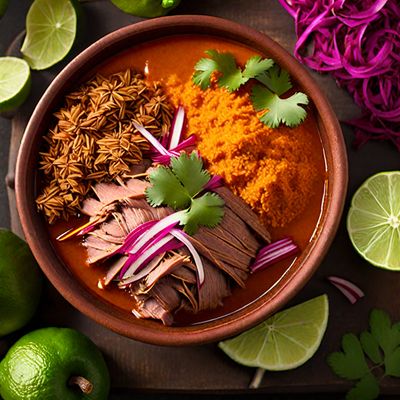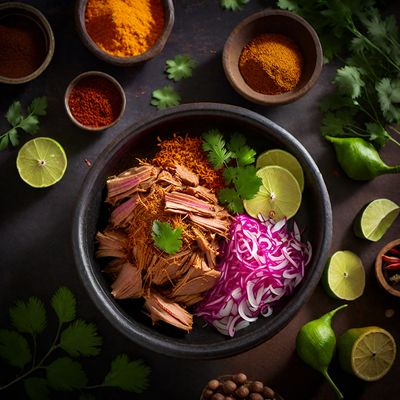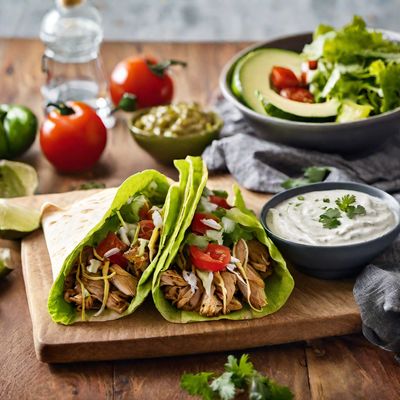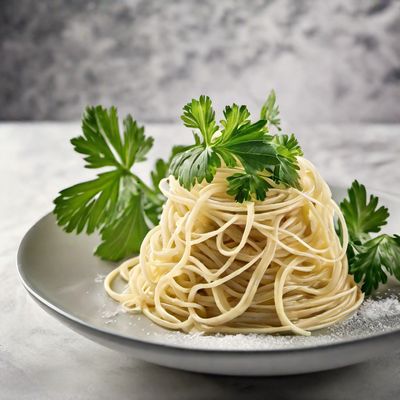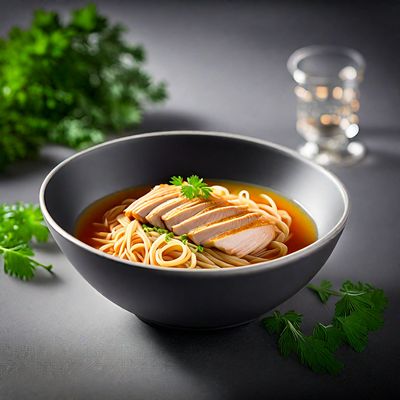
Recipe
Molecular Gastronomy Cochinita Pibil
The Transformed Cochinita Pibil: A Molecular Gastronomy Delight
4.8 out of 5
In the realm of molecular gastronomy, we reimagine the traditional Mexican dish, Cochinita Pibil. This innovative adaptation combines scientific techniques with the vibrant flavors of the original cuisine, resulting in a visually stunning and delectable experience.
Metadata
Preparation time
720 minutes (12 hours)
Cooking time
20 minutes
Total time
740 minutes
Yields
4 servings
Preparation difficulty
Medium
Suitable for
Vegetarian, Vegan, Gluten-free, Dairy-free, Low-carb
Allergens
N/A
Not suitable for
Nut-free, Soy-free, Paleo, Keto, High-protein
Ingredients
While the traditional Cochinita Pibil is slow-cooked in a banana leaf, our molecular gastronomy version focuses on transforming the textures and presentation. By utilizing modern culinary techniques, we create a dish that surprises and delights the senses. We alse have the original recipe for Cochinita pibil, so you can check it out.
-
500g (1.1 lb) pork shoulder, sous vide 500g (1.1 lb) pork shoulder, sous vide
-
50g (1.8 oz) achiote paste 50g (1.8 oz) achiote paste
-
2 oranges, juiced 2 oranges, juiced
-
2 limes, juiced 2 limes, juiced
-
4 cloves garlic, minced 4 cloves garlic, minced
-
1 tsp ground cumin 1 tsp ground cumin
-
1 tsp dried oregano 1 tsp dried oregano
-
1 tsp ground cinnamon 1 tsp ground cinnamon
-
1 tsp salt 1 tsp salt
-
1 tsp black pepper 1 tsp black pepper
-
10g (0.35 oz) agar-agar 10g (0.35 oz) agar-agar
-
500ml (2 cups) water 500ml (2 cups) water
-
50g (1.8 oz) beetroot, grated 50g (1.8 oz) beetroot, grated
-
10g (0.35 oz) xanthan gum 10g (0.35 oz) xanthan gum
-
100ml (0.4 cup) orange juice 100ml (0.4 cup) orange juice
-
100ml (0.4 cup) lime juice 100ml (0.4 cup) lime juice
-
50g (1.8 oz) sugar 50g (1.8 oz) sugar
-
10g (0.35 oz) calcium lactate 10g (0.35 oz) calcium lactate
-
10g (0.35 oz) sodium alginate 10g (0.35 oz) sodium alginate
-
500ml (2 cups) water (for spherification) 500ml (2 cups) water (for spherification)
-
Fresh cilantro, for garnish Fresh cilantro, for garnish
Nutrition
- Calories (kcal / KJ): 350 kcal / 1465 KJ
- Fat (total, saturated): 15g, 5g
- Carbohydrates (total, sugars): 20g, 5g
- Protein: 30g
- Fiber: 5g
- Salt: 2g
Preparation
-
1.Preheat a water bath to 65°C (149°F).
-
2.In a bowl, combine achiote paste, orange juice, lime juice, minced garlic, cumin, oregano, cinnamon, salt, and black pepper. Mix well.
-
3.Place the pork shoulder in a vacuum-sealed bag and pour the marinade over it. Seal the bag and cook in the water bath for 12 hours.
-
4.Remove the pork from the bag and shred it using two forks.
-
5.In a saucepan, combine agar-agar and water. Bring to a boil and simmer for 5 minutes. Remove from heat and let it cool slightly.
-
6.In a blender, combine the cooked agar-agar mixture and grated beetroot. Blend until smooth.
-
7.Pour the mixture into a flat container and let it set in the refrigerator for 1 hour.
-
8.Once set, cut the beetroot gel into small cubes.
-
9.In a separate bowl, combine xanthan gum, orange juice, lime juice, and sugar. Mix until the sugar is dissolved.
-
10.In a new bowl, dissolve calcium lactate in water.
-
11.In another bowl, dissolve sodium alginate in water.
-
12.Using a spoon, drop small cubes of beetroot gel into the calcium lactate solution. Let them sit for 2 minutes.
-
13.Carefully remove the beetroot gel cubes from the calcium lactate solution and transfer them to the sodium alginate solution. Let them sit for 3 minutes.
-
14.Remove the beetroot gel cubes from the sodium alginate solution and rinse them gently with water.
-
15.Serve the sous vide pork shoulder topped with the beetroot gel cubes. Garnish with fresh cilantro.
Treat your ingredients with care...
- Achiote paste — Use gloves when handling achiote paste as it can stain your hands and clothes.
- Agar-agar — Make sure to dissolve agar-agar completely to avoid lumps in the gel.
- Xanthan gum — Sprinkle xanthan gum slowly into the liquid while whisking to prevent clumping.
- Calcium lactate — Dissolve calcium lactate in cold water to ensure proper incorporation.
- Sodium alginate — When using sodium alginate, avoid stirring vigorously to prevent excessive air bubbles.
Tips & Tricks
- For a smoky flavor, you can add a small amount of liquid smoke to the marinade.
- Experiment with different fruit juices for the spherification process to create unique flavors.
- Serve the Cochinita Pibil with warm tortillas and pickled onions for a traditional touch.
- If you don't have a sous vide machine, you can slow-cook the pork shoulder in the oven at 120°C (250°F) for 4-6 hours.
- To enhance the presentation, serve the dish on a bed of edible flowers or microgreens.
Serving advice
Serve the Molecular Gastronomy Cochinita Pibil as a main course, accompanied by warm tortillas, pickled onions, and a side of refried beans. The vibrant colors and textures of the dish will impress your guests.
Presentation advice
Arrange the sous vide pork shoulder on a plate, placing the beetroot gel cubes strategically around it. Garnish with fresh cilantro leaves for a pop of green. Drizzle some of the marinade sauce over the pork for added flavor and visual appeal.
More recipes...
For Cochinita pibil » Browse all
For Mexican cuisine » Browse all
More Mexican cuisine dishes » Browse all

Crema de flor de calabaza
Zucchini flower soup
Crema de flor de calabaza is a traditional Mexican soup made with squash blossoms. It is a light and flavorful dish that is perfect for a warm summer day.
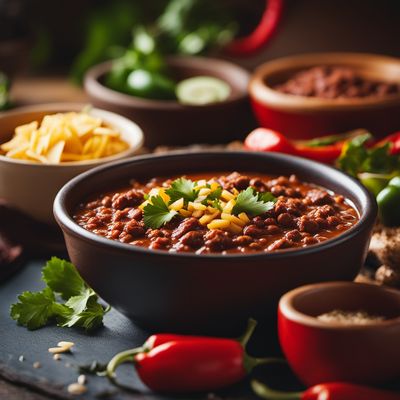
Chili con Carne
Chili con Carne is a popular Tex-Mex dish that is made with ground beef and chili peppers. It is a hearty and flavorful dish that is perfect for...
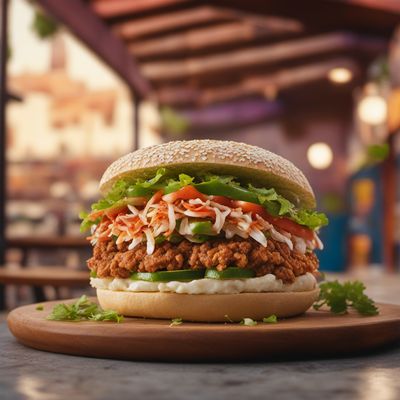
Cemita
A classic sandwich from Puebla, Mexico, the cemita is a hearty and flavorful option for lunch or dinner.
